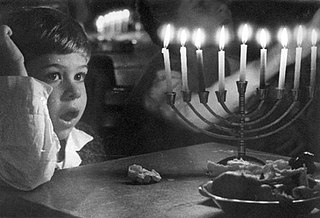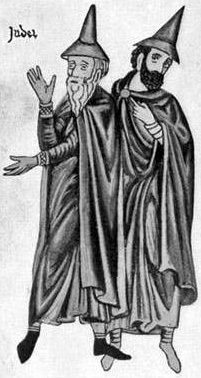
Marriage in Judaism is the documentation of a contract between a Jewish man and a Jewish woman in which God is involved. In Judaism, a marriage can end either because of a divorce document given by the man to his wife, or by the death of either party. Certain details, primarily as protections for the wife, were added in Talmudic times.

The Jerusalem Talmud or Palestinian Talmud, also known as the Talmud of the Land of Israel, is a collection of rabbinic notes on the second-century Jewish oral tradition known as the Mishnah. Naming this version of the Talmud after Palestine or the Land of Israel—rather than Jerusalem—is considered more accurate, as the text originated mainly from Galilee in Byzantine Palaestina Secunda rather than from Jerusalem, where no Jews lived at the time.
Yibbum is the form of levirate marriage found in Judaism. As specified by Deuteronomy 25:5–10, the brother of a man who died without children is permitted and encouraged to marry the widow. However, if either of the parties refuses to go through with the marriage, both are required to go through a ceremony known as halizah, involving a symbolic act of renunciation of their right to perform this marriage.

Rabbi Tarfon or Tarphon, a Kohen, was a member of the third generation of the Mishnah sages, who lived in the period between the destruction of the Second Temple and the fall of Betar.
Yevamot is a tractate of the Talmud that deals with, among other concepts, the laws of Yibbum, and, briefly, with conversion to Judaism. This tractate is the first in the order of Nashim.

Ketubot is a tractate of the Mishnah and the Talmud in the order of Nashim. It deals with a variety of marital responsibilities, especially those intended for the marital contract, also named the ketubah. Due to the wide breadth of subjects discussed in this tractate, Ketubot is often referred to as the Shas katan .

Naso or Nasso is the 35th weekly Torah portion in the annual Jewish cycle of Torah reading and the second in the Book of Numbers. It constitutes Numbers 4:21–7:89. The parashah addresses priestly duties, camp purification, restitution for wrongs committed, the wife accused of unfaithfulness, the nazirite, the Priestly Blessing, and consecration of the Tabernacle. Naso has the largest number of letters, words, and verses of any of the 54 weekly Torah portions. The parashah is made up of 8,632 Hebrew letters, 2,264 Hebrew words, 176 verses, and 311 lines in a Torah Scroll.
Jose ben Helpetha, commonly known as Jose ben Halafta (IPA:) was a tanna of the fourth generation. He is the fifth-most-frequently mentioned sage in the Mishnah. Yose Ben Halafta is the one of two rabbis called Rabbi Yose in the Talmud; the other being Jose ben Zimra, an amora.

Matot, Mattot, Mattoth, or Matos is the 42nd weekly Torah portion in the annual Jewish cycle of Torah reading and the ninth in the Book of Numbers. It comprises Numbers 30:2–32:42. It discusses laws of vows, the destruction of Midianite towns, and negotiations of the Reubanites and Gadites to settle land outside of Israel.

Ki Teitzei, Ki Tetzei, Ki Tetse, Ki Thetze, Ki Tese, Ki Tetzey, or Ki Seitzei is the 49th weekly Torah portion in the annual Jewish cycle of Torah reading and the sixth in the Book of Deuteronomy. It comprises Deuteronomy 21:10–25:19. The parashah sets out a series of miscellaneous laws, mostly governing civil and domestic life, including ordinances regarding a beautiful captive of war, inheritance among the sons of two wives, a wayward son, the corpse of an executed person, found property, coming upon another in distress, rooftop safety, prohibited mixtures, sexual offenses, membership in the congregation, camp hygiene, runaway slaves, prostitution, usury, vows, gleaning, kidnapping, repossession, prompt payment of wages, vicarious liability, flogging, treatment of domestic animals, yibbum, weights and measures, and wiping out the memory of Amalek.
Nazir is a treatise of the Mishnah and the Tosefta and in both Talmuds, devoted chiefly to a discussion of the laws of the Nazirite laid down in Numbers 6:1-21. In the Tosefta its title is Nezirut ("Nazariteness"). In most of the editions of the Mishnah, this treatise is the fourth in the order Nashim, and it is divided into 9 chapters, containing 48 paragraphs in all.

Asceticism is a lifestyle characterized by abstinence from sensual pleasures, often for the purpose of pursuing spiritual goals. Asceticism has not been a dominant theme within Judaism, but minor-to-significant ascetic traditions have been a part of Jewish spirituality.
Forbidden relationships in Judaism are intimate relationships which are forbidden by prohibitions in the Torah or rabbinical injunctions.
Impurity of the land of the nations is a rabbinic edict stipulating a specified degree of tumah (impurity) on all lands outside the Land of Israel. The demarcation lines of foreign lands effectually included all those lands not settled by the people of Israel during their return from the Babylonian exile during the Second Temple period, and was meant to dissuade the priests of Aaron's lineage from venturing beyond the Land of Israel where graves were unmarked, and who may inadvertently contract corpse uncleanness and thereby eat their bread-offering (Terumah), unawares, in a state of ritual impurity and becoming liable thereby to kareth. The declaration with respect to foreign lands includes also the "virgin soil" of those lands, and was, therefore, a safeguard meant to prevent the priests from inadvertently transgressing the Law of Moses.

Nedarim is a masechet of the order of Nashim of the Mishnah and the Talmud. Its subject is laws relating to the neder, a kind of vow or oath in Judaism.
Gittin is a tractate of the Mishnah and the Talmud, and is part of the order of Nashim. The content of the tractate primarily deals with the legal provisions related to halakhic divorce, in particular, the laws relating to the Get, although the tractate contains a number of other social provisions which are only vaguely related to that subject. The tractate also contains numerous historical references relating to the time of the Jewish-Roman wars-Roman war and the destruction of the Temple as well as the Jewish uprising. The laws of the divorce itself, including when a divorce is permitted or even required, are discussed in other tractates, namely Ketubot.

Kiddushin is a masekhet or tractate of the Mishnah and the Talmud, and is part of the order of Nashim. The content of the tractate primarily deals with the legal provisions related to halakhic engagement and marriage.
In Jewish tradition, the term ay'lonit refers to a person born female at birth who later developed "male characteristics". During puberty, an ay'lonit will not develop secondary-sex characteristics and is assumed to be infertile. The secondary-sex characteristics are referred to as "male" characteristics in the Talmud. "Male characteristics" can include a deeper voice, painful intercourse, small breasts, a lack of pubic hair, a period, and a normal libido









